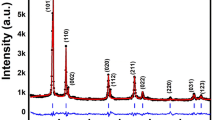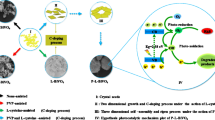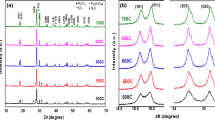Abstract
Herein, the delta phase bismuth oxide (δ-Bi2O3) with high crystallinity can be obtained at room temperature through a sol–gel route in the presence of VO3 −. The as-synthesized δ-Bi2O3 photocatalysts are characterized using synchrotron-based techniques, including ultraviolet photoelectron spectroscopy, X-ray absorption near edge structure, and extended X-ray absorption fine structure. Results show that V species plays a key role in stabilizing the δ phase of Bi2O3. With increasing V/Bi molar ratio, crystallinity, light absorption ability, and specific surface area increase. The V species predominantly exists in the +5 oxidation state, irrespective of V loading amount, and is tetrahedrally coordinated to four O atoms with a bond length of 1.716 Å. The δ-Bi2O3 photocatalysts show appreciable visible light activity for the decomposition of atenolol, an important β-blocker drug.






Similar content being viewed by others
References
Sudrajat H, Babel S, Sakai H, Takizawa S (2016) Rapid enhanced photocatalytic degradation of dyes using novel N-doped ZrO2. J Environ Manag 165:224–234
Sudrajat H, Babel S (2016) An innovative solar photoactive system N-WO3@polyester fabric for degradation of amaranth in a thin-film fixed-bed reactor. Sol Energy Mater Sol Cells 2149:294–303
Sudrajat H, Babel S (2016) A new, cost-effective solar photoactive system N-ZnO@ polyester fabric for degradation of recalcitrant compound in a continuous flow reactor. Mater Res Bull 83:369–378
Bhatkhande DS, Pangarkar VG, Beenackers AA (2002) Photocatalytic degradation for environmental applications—a review. J Chem Technol Biotechnol 77:102–116
Wen J, Xie J, Chen X, Li X (2017) A review on gC3N4-based photocatalysts. Appl Surf Sci 391:72–123
Gaya UI, Abdullah AH (2008) Heterogeneous photocatalytic degradation of organic contaminants over titanium dioxide: a review of fundamentals, progress and problems. J Photochem Photobiol C 9:1–12
Hou W, Cronin SB (2013) A review of surface plasmon resonance-enhanced photocatalysis. Adv Funct Mater 23:1612–1619
Kumar SG, Devi LG (2011) Review on modified TiO2 photocatalysis under UV/visible light: selected results and related mechanisms on interfacial charge carrier transfer dynamics. J Phys Chem A 115:13211–13241
Wu Y-C, Huang Y-T, Yang H-Y (2016) Crystallization mechanism and photocatalytic performance of vanadium-modified bismuth oxide through precipitation processes at room temperature. CrystEngComm 18:6881–6888
Turkoglu O, Altiparmak F, Belenli I (2003) Stabilization of Bi2O3 polymorphs with Sm2O3 doping. Chem Pap 57:304–308
Hervoches CH, Greaves C (2012) Variable temperature neutron diffraction study of Bi3ReO8 oxide ion conductor. Solid State Ion 217:46–53
Oprea B, Radu T, Simon S (2013) XPS investigation of atomic environment changes on surface of B2O3–Bi2O3 glasses. J Non Cryst Solids 379:35–39
Jiang H-Y, Li P, Ye J, Lin J (2015) Synthesis and photocatalytic properties of metastable β-Bi2O3 stabilized by surface-coordination effects. J Mater Chem A 3:5119–5125
Wu JM, Liou LB (2011) Room temperature photo-induced phase transitions of VO2 nanodevices. J Mater Chem 21:5499–5504
Biesinger MC, Lau LW, Gerson AR, Smart RSC (2010) Resolving surface chemical states in XPS analysis of first row transition metals, oxides and hydroxides: Sc, Ti, V, Cu and Zn. Appl Surf Sci 257:887–898
Fan H, Li H, Liu B, Lu Y, Xie T, Wang D (2012) Photoinduced charge transfer properties and photocatalytic activity in Bi2O3/BaTiO3 composite photocatalyst. ACS Appl Mater Interfaces 4:4853–4857
Yan J, Wu G, Guan N, Li L, Li Z, Cao X (2013) Understanding the effect of surface/bulk defects on the photocatalytic activity of TiO2: anatase versus rutile. Phys Chem Chem Phys 15:10978–10988
Li X, Yu J, Jaroniec M (2016) Hierarchical photocatalysts. Chem Soc Rev 45:2603–2636
Acknowledgements
This work is supported by Ton Duc Thang University. The Synchrotron Light Research Institute (Public Organization) is acknowledged for providing beamtime at BL3.2a:PES and BL8:XAS. Thanks also go to K. Hirano and S. Kawaguchi of Kyushu University for fruitful discussions and M. Asnal for technical assistance.
Author information
Authors and Affiliations
Corresponding author
Rights and permissions
About this article
Cite this article
Sudrajat, H. Chemical state and local structure of V species incorporated in δ-Bi2O3 photocatalysts. J Mater Sci 53, 1088–1096 (2018). https://doi.org/10.1007/s10853-017-1565-9
Received:
Accepted:
Published:
Issue Date:
DOI: https://doi.org/10.1007/s10853-017-1565-9




